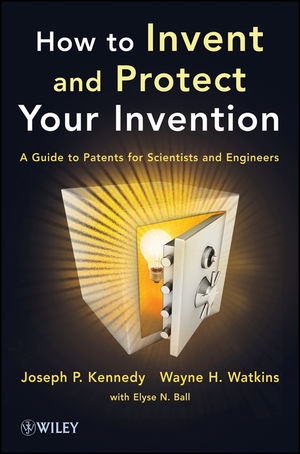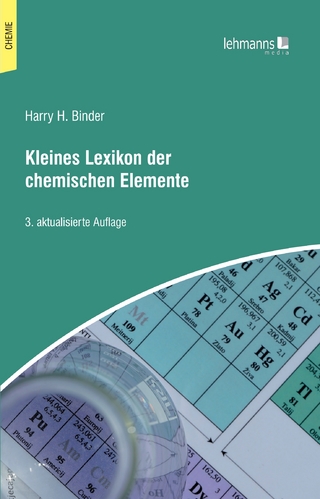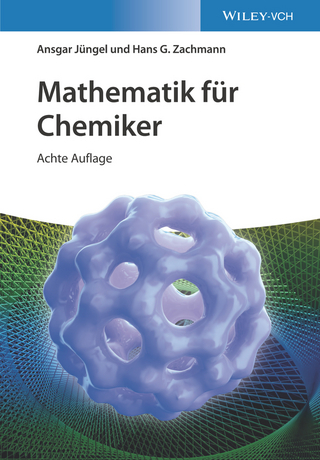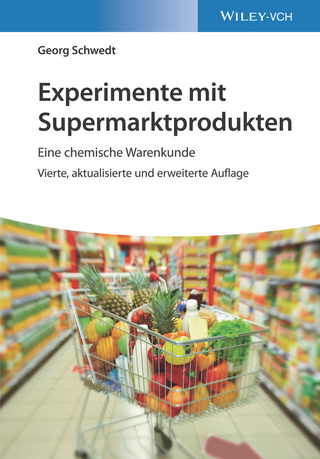
How to Invent and Protect Your Invention
John Wiley & Sons Inc (Verlag)
978-1-118-36937-1 (ISBN)
- Lieferbar (Termin unbekannt)
- Versandkostenfrei innerhalb Deutschlands
- Auch auf Rechnung
- Verfügbarkeit in der Filiale vor Ort prüfen
- Artikel merken
A straightforward guide to inventing, patenting, and technology commercialization for scientists and engineers Although chemists, physicists, biologists, polymer scientists, and engineers in industry are involved in potentially patentable work, they are often under-prepared for this all-important field. This book provides a clear, jargon-free, and comprehensive overview of the patenting process tailored specifically to the needs of scientists and engineers, including:
Requirements for a patentable invention
How to invent
New laws created by President Obama's 2011 America Invents Act
The process of applying for and obtaining a patent in the U.S. and in foreign countries
Commercializing inventions and the importance of innovation
Based on lecture notes refined over twenty-five years at The University of Akron, How to Invent and Protect Your Invention contains practical advice, colorful examples, and a wealth of personal experience from the authors.
JOSEPH P. KENNEDY, PhD, MBA, FACS, is a Distinguished Professor of Polymer Science and Chemistry at The University of Akron. He has authored four scientific books and more than 700 publications, and is the inventor of more than 100 issued U.S. patents, which have generated billions of dollars in revenue. His research interests include ionic polymerization and the design and creation of useful polymeric materials, particularly for medical applications. WAYNE H. WATKINS, BS (engineering), MBA, JD, is Associate Vice President for Research at The University of Akron, adjunct professor of law, and Vice President of the University of Akron Research Foundation where he leads technology commercialization initiatives. He has particular expertise in intellectual property management and new enterprise creation and growth. He is a principal in three companies in chemistry and biotechnology. ELYSE N. BALL, BS (journalism), JD, is a Project Manager for the University of Akron Research Foundation where she regularly works on technology licensing projects and supporting university startup companies. She is involved in technology development in the polymer science, advanced energy, and biomedical fields.
Preface: How This Book Came to Be and for Whom It Is Written xi
Acknowledgments xix
Abbreviations xxi
1. The U.S. Patent System 1
1.1. What is a Patent? 1
1.2. Why Should You File A Patent? 5
2. Origins of U.S. Patent Law 7
2.1. A Brief History of Patent Law 8
2.2. The Fountainhead: The Constitution and the U.S. Patent System 9
2.3. Are Patents a Monopoly? 11
3. How to Invent: Intellectual Aspects Of Inventing 12
3.1. On the Definition of Creativity 12
3.2. A Flaw in Patent Law 13
3.3. Patentable Creativity 14
3.4. Intellectual Requirements of Inventing 15
3.5. The Process and Product of Inventing 16
3.6. Pioneering versus Mediocre Inventions: The Touch of the Expert 17
3.7. The Importance of Industrial Experience 17
3.8. The Ultimate Goal: Innovation 18
4. A Short Summary of Intellectual Property 20
4.1. Patents 21
4.2. Trade Secrets 21
4.3. Copyrights 22
4.4. Trademarks and Servicemarks 23
4.5. Other Types of Intellectual Property 24
5. Requirements of Patentability 26
5.1. What is Patentable? 26
5.2. Patentable and NonPatentable Subject Matter 27
5.3. The Three Classes of Patents 28
5.4. The First Law of Inventing 28
5.4.1. Utility 29
5.4.2. Novelty 31
5.4.2.1. The One-Year Rule 32
5.4.2.2. Derivation Proceedings 33
5.4.2.3. Anticipation 35
5.4.3. Unobviousness 35
5.4.3.1. Aggregates and Composites 37
5.4.3.2. The Teaching-Suggestion-Motivation Test 38
5.4.3.3. Secondary Factors Suggesting Unobviousness 39
5.4.3.4. The Doctrine of Inherency 40
5.4.3.5. Combination of References 41
5.4.3.6. New Compounds by Purification 41
5.4.3.7. Differences Between Novelty and Unobviousness 42
5.4.3.8. Why We Need Unobviousness 43
5.4.3.9. Summary of the Invention Content Law 43
5.5. The Second Law of Inventing 44
5.5.1. Conception 44
5.5.2. Reduction to Practice 46
5.5.3. The Prophetic Patent 46
5.6. The Structure of the Patent Document 48
5.6.1. The Cover Sheet 48
5.6.2. Specification 50
5.6.3. Claims 52
6. How Does the Patent Process Work? 55
6.1. The Notebook 56
6.2. The Provisional Patent Application 56
6.3. The (Regular or Nonprovisional) Patent Application 58
6.4. Prosecution: Convincing the Patent Examiner 60
6.4.1. Starting the Prosecution Process 61
6.4.2. The First Office Action 61
6.4.3. Allowances and Rejections by the PTO 62
6.4.4. The Duty of Candor 63
6.5. Continuation, Continuation-in-Part, and Divisional Applications 64
6.5.1. Continuation Applications 65
6.5.1.1. Differences Between Priority Dates and Filing Dates 65
6.5.1.2. Requirements for a Continuation Application 66
6.5.2. Continuation-in-Part Applications 67
6.5.3. Divisional Applications 68
6.6. Allowance and Issuance 68
6.7. Loss of Patent Rights 68
6.8. Challenges and Changes to Issued Patents 69
6.8.1. Post-Grant Review 69
6.8.2. Inter Partes Review 70
6.8.3. Reissue Application and Reissue Patents 70
6.8.4. Supplemental Examination 71
6.8.5. Summary of Post-Grant Proceedings 71
6.9. Summary of Chapters 5 and 6 73
7. Infringement and Freedom to Operate 74
7.1. The Parable of the Knife 75
7.1.1. The Story of Chlorobutyl Rubber 76
7.1.2. Anticipation versus Domination 77
7.2. Types of Infringement 77
7.2.1. Literal (or Direct) Infringement 78
7.2.2. The Doctrine of Equivalents 78
7.2.3. Contributory Infringement 79
7.3. Infringement Suits 79
7.4. When to Sue an Infringer 80
7.5. Freedom to Operate 80
7.5.1. Patent Trolls 81
7.5.2. Submarine Patents 82
7.6. Prior Commercial Use Rights 82
7.6.1. Personal Defenses 82
7.6.2. Exceptions to the Prior Commercial Use Defense 83
8. Biotechnology, Computer Software, and Business Method Patents 84
8.1. Biology Meets Patents 85
8.1.1. The Supreme Court: Living Things Are Patentable 85
8.1.2. The Budapest Treaty 86
8.1.3. The Consequences of the Supreme Court’s Ruling 86
8.2. Computer Software Patents 89
8.3. Business Method Patents 90
9. Who Is the Inventor? 91
9.1. Conceiving an Inventive Idea 92
9.2. Joint Inventors 93
9.3. Naming Inventors on Patent Applications 95
9.4. Qualifications to Be an Inventor 95
10. Ownership 96
10.1. Selling, Licensing and Assigning Patents 97
10.2. Hired-to-Invent and Shop Rights 97
10.3. Inventing on Your Own Time 98
10.4. Non-Compete Agreements 98
10.5. The Bayh–Dole Act 99
10.5.1. March-In Rights 100
10.5.2. University Technology Transfer 101
11. Translating Ideas into Economic Reward 102
11.1. The Costs of Patenting 102
11.1.1. Legal Fees 103
11.1.2. Patent Application Fees 103
11.1.3. Patent Maintenance Fees 104
11.2. Assessment 104
11.2.1. Technology Validation 105
11.2.2. Protection Validation 105
11.2.2.1. Assessing Patent Protection 105
11.2.2.2. Assessing Trade Secret Protection 106
11.2.2.3. The Economic Espionage Act 107
11.2.2.4. Non-Disclosure Agreements (NDAs) 108
11.2.3. Commercial Viability and Market Assessment 109
11.3. Selling and Licensing a Patent 110
11.3.1. Licensors and Licensees 110
11.3.2. Exclusive versus Nonexclusive Licenses 111
11.4. Start-Ups, Spin-Outs, and Joint Ventures 112
11.5. Patenting and Marketing Departments; Technology Transfer Offices 113
11.6. Patent Valuation 114
12. Foreign Patents 116
12.1. Distinctive Features of U.S. Patent Law 117
12.2. The International Patent Cooperation Treaty 118
12.2.1. PCT Examination Procedures 118
12.2.2. Deciding Whether to File a PCT 119
12.2.3. The Patent Prosecution Highway 119
12.3. The European Patent Union 120
12.3.1. European Patent Office Procedures 120
12.3.2. Nationalization of European Patents 121
12.4. Other Foreign Patent Practices 121
12.4.1. Claims Interpretation 121
12.4.2. Patent Examination Procedures Abroad 122
12.4.3. Centralized Patent Offices 122
12.4.4. Procedures for Rewarding Inventors 122
12.5. Enforcing Patents Abroad 123
12.6. Choosing Whether to File a Foreign Patent Application 124
13. Innovation 125
13.1. Innovation Is More Than Invention 125
13.2. What Drives Innovation 126
13.3. The Law of Innovation 126
13.4. Companies and Innovation 127
13.5. The Innovation and Job Creation Relationship 127
13.6. Discovery Push versus Market Pull Innovation 128
13.7. Incremental versus Disruptive Innovation 128
13.8. Sources of Innovation 129
13.9. Innovation and Public Policy 129
14. Concluding Thoughts 131
14.1. Is the Patent System Worth the Costs? 131
14.2. The Patent System Leads to Additional Research and Knowledge Creation 133
14.3. Fostering Competition 134
14.4. Results of Ignorance of the Patent System 135
14.5. How Law and Technology Yield Patents 136
Appendix 1: Important Forms 139
Appendix 2: Self-assessment Questions 177
Glossary 196
Index 209
| Co-Autor | Elyse N. Ball |
|---|---|
| Verlagsort | New York |
| Sprache | englisch |
| Maße | 155 x 236 mm |
| Gewicht | 435 g |
| Themenwelt | Naturwissenschaften ► Chemie ► Allgemeines / Lexika |
| Recht / Steuern ► Allgemeines / Lexika | |
| Recht / Steuern ► EU / Internationales Recht | |
| Recht / Steuern ► Wirtschaftsrecht | |
| Technik | |
| ISBN-10 | 1-118-36937-8 / 1118369378 |
| ISBN-13 | 978-1-118-36937-1 / 9781118369371 |
| Zustand | Neuware |
| Haben Sie eine Frage zum Produkt? |
aus dem Bereich


